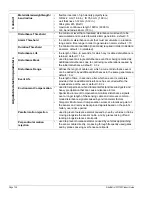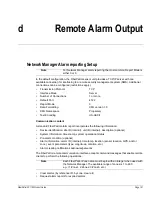
FiberPatrol FP1150 Product Guide
Page 141
d
Remote Alarm Output
Network Manager Alarm reporting Setup
In the default configuration, the FiberPatrol sensor unit provides a TCP/IP server with one
available connection for interfacing to a remote security management system (SMS). Additional
connections can be configured (restrictions apply).
•
Transmission Protocol
TCP
•
Interface Mode
Server
•
Number of Connections
1 or more
•
Default Port
4122
•
Report Mode
0
•
Data Formatting
XML version 1.0
•
XML Namespace
Proprietary
•
Text Encoding
US-ASCII
Communication content
A standard FiberPatrol alarm report incorporates the following information:
•
Device identification: site ID (internal), unit ID (internal), description (optional)
•
System information: time stamp, system operational status
•
Pre-alarm condition (optional)
•
Alarm information: alarm ID (internal), time tamp, location (sensor location, GPS, and/or
zone), event parameters (type, magnitude, duration, etc.)
•
Alarm clearing notifications acknowledgements
The FiberPatrol remote communication interface accepts command messages that enable remote
clients to perform the following operations:
•
Clear alarms (by reference ID, by zone, clear all)
•
Request alarm reports for expired alarms
Note
For Network Manager alarm reporting the most common Report Mode is
either 0 or 6.
Note
Each FiberPatrol Zone name must begin with an integer when used with
the Network Manager. The available range of zones is 1 to 480.
e.g., (1:Zone1, 2:Zone2, 3:Zone3, etc.)
















